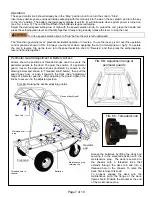
Battery charger use and operation:
Working with or near lead acid batteries is dangerous. Batteries contain sulfuric acid and produce explosive gases. A
battery explosion could result in loss of eyesight and/or serious burns.
Do not smoke, or allow a spark or flame, near batteries. Only charge the batteries in a clean, dry, and well-ventilated
location. Do not lay tools or metallic items on top of any battery. All repairs to a battery must be made by experienced
and qualified personnel.
Before working with batteries, remove personal items such as rings, bracelets, necklaces, and watches. Batteries
produce sufficient energy to weld jewelry to metal, and to cause severe burns.
Always have fresh water and soap nearby in case battery acid contacts skin, clothing, or eyes.
Operating the cart with a low battery voltage can cause premature motor contact failure.
Do not expose the cart or charger to moisture (rain, snow, sleet, etc.).
Replace defective cords or wires immediately.
Check the water level of the batteries frequently.
The battery charger consists of 2 parts: 1) the charger; and 2) a power cord that plugs into the charger.
To charge the batteries, plug the female end of the power cord into the charger; connect the charger plug to the charger
socket of the operation control panel; plug the male end of the power cord into a (standard) 115V wall receptacle; and
then press the power switch on the charger.
Do not connect the charger to an extension cord unless it is unavoidable. If an extension cord is
necessary, it should be as short as possible with a large cross-section. A cord of small cross-section and/or longer length
will decrease the output of the charger, and consequently will increase the time necessary to charge the batteries. This
can also cause the 115V cord to overheat.
When properly connected, a series of 3 LED’s indicates the status of current flowing to the battery, as follows: Power LED
is always green when charger is plugged in.
The status light is as follows:
Red only – the charger is providing full output to the battery.
Yellow – the charger is “topping off” the battery.
Green – the charger is providing a “float,” or maintenance, charge.
Unplug the charger before using the cart.
Charger
Operation control panel
Charger socket
on operation
control panel
Charger plug
Power cord
Page 8 of 10
Summary of Contents for OROAD-400
Page 5: ......




























